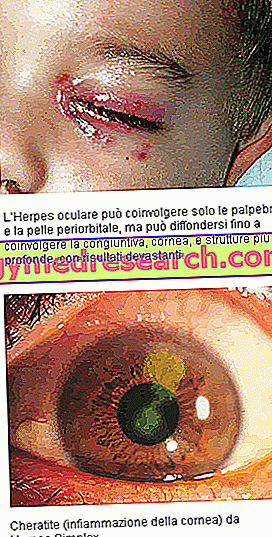The importance of vaccination
Pneumococcal infections can be highly invasive and sometimes cause considerable damage: not by chance, severe pneumococcal diseases - such as pneumonia, meningitis, bacteremia, osteomyelitis, septicemia and septic arthritis - are important factors of morbidity. To avoid complications, sometimes inevitable after a pneumococcal infection, vaccination is recommended: the purpose of the vaccine is to "instruct" the immune system to defend itself from possible attacks by S. pneumoniae . Like all vaccines, even that for pneumococcus stimulates the immune system to recognize the antigenic components of the bacterium and produce them against antibodies; in this way, in the event of a pneumococcal attack, the defense system produces antibodies more rapidly, erecting a sort of shield against the disease.
Types of vaccine
Pneumococcal vaccines include two types:
- Heptavalent conjugate vaccine (eg prevenar): it is a vaccine linked - therefore conjugated - to a protein (vector) to increase its effectiveness, therefore favoring a better recognition by the body's defense system; in this way, the vaccine protects the host from the 7 pneumococcal subtypes most involved in infections ("heptavalent"). Vaccination with this drug is recommended in children under the age of 5; in the adult it has not yet been completely tested. The vaccine is composed of very small amounts of capsular polysaccharides of the pneumococcus, purified and bound to a vector that favors the recognition by the body's immune system. To stimulate a better response, the vaccine is fixed to a particular compound containing aluminum. The heptavalent conjugate vaccine exerts an excellent protective action against invasive diseases sustained by pneumococcus, in particular pneumonia, otitis media and acute, bacteremia, sepsis and meningitis. The heptavalent conjugate vaccine covers 78% of invasive pneumococcal strains.
- 23-valent vaccine: active against 23 pneumococcal serotypes, involved in the vast majority of pneumonia cases. This vaccine form, unlike the previous one, can also be used by adults. Especially in the past, this vaccine showed a limited diffusion, due to the patient's modest immunogenic capacity, particularly in the first few years of life; furthermore, the vaccine is not able to evoke an immunological memory in all age groups. The "problem" was soon solved by conjugating the capsular polysaccharides with specific transport proteins: in this case, it is possible to obtain an adequate immune response even in the smallest patients. The serotypes contained in the 23-valent vaccine cover 88% of invasive pneumococcal strains.
Method of administration
The vaccine for the prophylaxis of pneumococcal infections is administered intramuscularly: the injection is performed directly in the thigh muscle to infants younger than two years, or in the shoulder muscle to older patients.
For children between the ages of six weeks and six months, a first administration of the drug is expected followed by three boosters, which the patient must undergo at intervals of about 30 days (for the first three doses). For the last recall, it is advisable to wait for the 11th or 15th month of age.
For children aged between 7 and 11 months, the planned vaccine doses are three: the first two doses must be administered with an interval of thirty days; the third dose, on the other hand, must be taken at the end of the second year.
There are two vaccination doses for primary pneumococcal prevention for children aged 12 to 23 months, to be taken 60 days apart.
A single dose is recommended for children aged between 2 and 5 years.
For adult patients, vaccination consists of administering a single dose of vaccine; vaccination recalls are recommended only for people with nephrotic syndrome and asplenics (patients whose spleen has been removed).
Side effects
The pneumococcal vaccine should NOT be administered in case of allergy to one or more components. In the event of a high fever, it is not recommended to subject the child to vaccination: in similar circumstances, it is recommended to wait until complete remission of symptoms.
In general, the most common side effects following vaccination are: alteration and loss of appetite, fever, irritability, skin lesions at the site of drug inoculation, lethargy / drowsiness and sleep disorders in general.
Indications
The vaccine for the primary prophylaxis of pneumococcal infections is recommended for small children, especially if they attend kindergartens, nursery schools or collective environments. The same goes for the elderly who attend retirement homes or welfare communities in general.
It has been observed that some patients tend to develop severe pneumococcal infections more easily than others: subjects with anemia, diabetes, chronic bronchopulmonary disorders, impaired immune system, cancer, chronic kidney disease, and patients on long-term therapy with paracetamol or subjected to a splenectomy (removal of the spleen) are the preferential targets of the pneumococcus. For this reason, vaccination is also recommended for this category of subjects.
Considerations
The pneumococcal vaccine can be given in combination with other vaccines, such as the flu vaccine; in such circumstances, it is recommended to perform the two injections at two different points.
A problem to which the researchers have had to remedy is the change in the pneumococcal serotypes circulating in our country, following the development of the pneumococcal heptavalent vaccine: the vaccination has allowed, on one hand, a marked reduction of the pneumococcal infections corresponding to the serotype contained in the vaccine, on the other an increase in circulating serotypes NOT present in the vaccine.



